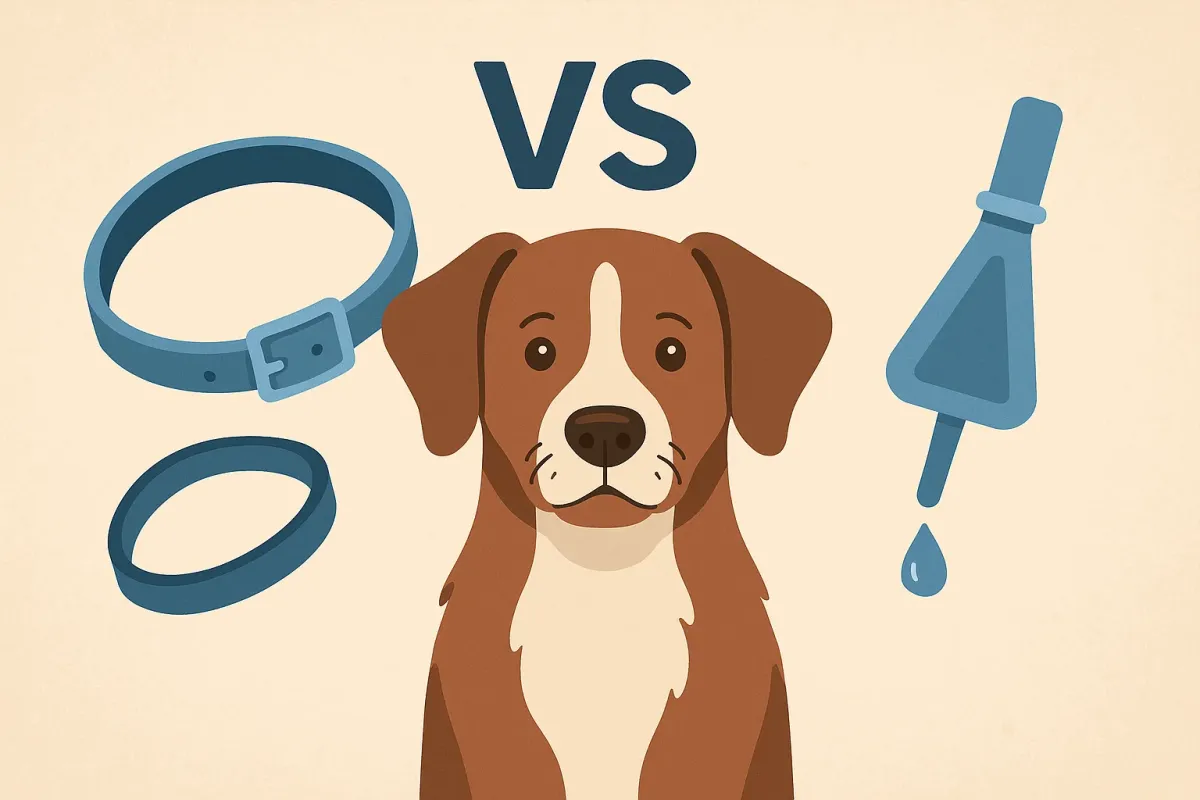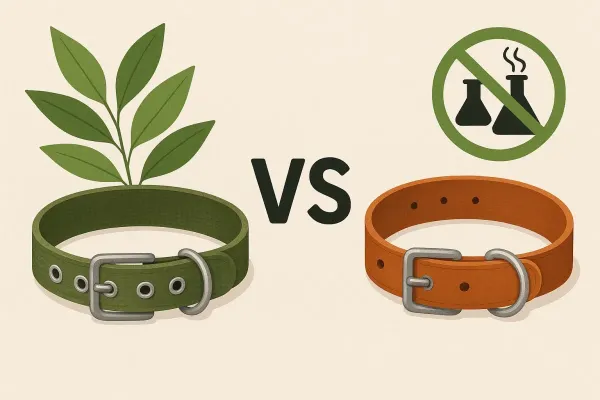
Last updated: October 10, 2025
Flea and tick collars vs spot-ons: which is more effective

Protecting your dog from fleas, ticks, and other parasites is essential for their health. Today there are two very popular methods: flea and tick collars and spot-on pipettes. Both aim for the same goal, but they work differently and offer distinct advantages depending on your dog’s type and lifestyle.
In this guide we compare flea and tick collars vs spot-ons in detail to help you choose the most effective, safe, and long-lasting option for your pet. Discover which protects best based on size, coat, and daily habits.
How flea and tick collars work
Flea and tick collars are an effective, long-lasting way to protect dogs against fleas, ticks, and other external parasites. They work by gradually releasing an active substance that spreads across the dog’s skin and coat, creating a protective layer that repels and eliminates parasites before they can bite or attach.
These collars are made from plastics that incorporate active ingredients, such as imidacloprid or flumethrin in chemical models, or natural essential oils in eco-friendly versions. Once fitted, the collar starts working continuously for several months with no additional applications needed.
Beyond efficacy, collars stand out for their convenience and duration. They can protect a dog for 6 to 8 months, depending on the brand, and some models are water-resistant, allowing the dog to bathe without losing protection. They’re also a cost-effective option over time since they don’t require monthly treatments like spot-ons.
Even so, it’s important to choose a collar suited to your dog’s size and age, as some sensitive animals may experience mild skin irritation if the collar isn’t fitted correctly or if the components aren’t suitable for their skin. When in doubt, consult your vet before use.
Bottom line: parasite collars offer continuous, practical, and effective protection for dogs that spend a lot of time outdoors, making them one of the most convenient solutions to keep them free of fleas and ticks year-round.
How spot-on pipettes work
Spot-on pipettes are a liquid solution applied directly to the dog’s skin, usually between the shoulder blades or along the back. They contain a combination of active ingredients that distribute through the skin’s lipid layer, creating a protective barrier that kills and repels fleas, ticks, and lice.
Application is simple: empty the tube’s contents onto the animal’s dry skin and let it absorb completely. Generally, a pipette provides protection for about one month, so you’ll need to reapply regularly to maintain effectiveness.
Spot-ons act quickly, becoming effective within hours of application. Some formulas also include compounds that help prevent the spread of eggs and larvae, disrupting the parasites’ life cycle.
After applying a spot-on, avoid bathing for at least 48 hours to preserve its effectiveness. It’s also best not to touch the treated area until fully dry—especially if there are children at home.
In short, spot-on treatments are a practical, effective option if you want targeted protection that’s easy to apply without extra accessories. They’re especially useful for dogs that don’t tolerate collars well or live in urban environments with lower tick exposure.
Quick comparison: collars vs spot-ons
Flea and tick collars and spot-ons are both highly effective at protecting dogs from fleas, ticks, and other external parasites. However, each has different characteristics worth weighing before choosing.
In terms of duration, collars have a clear advantage, protecting for six to eight months with no reapplication. Spot-ons, by contrast, last three to four weeks, meaning monthly applications to keep protection active.
Regarding water resistance, modern collars usually withstand baths and rain better, whereas spot-ons can lose efficacy if the dog gets wet soon after application. This makes collars more practical for active dogs or frequent swimmers.
As for ease of use, both options are simple, though a collar is fitted once and needs no maintenance, while spot-ons must be applied carefully to avoid skin contact with humans or product loss.
In terms of efficacy, both protect well against fleas, but collars often provide more complete defense against ticks, especially in rural settings. Spot-ons, meanwhile, may be better for indoor dogs or those with sensitive skin.
Looking at long-term cost, collars are more economical because a single product covers several months. Spot-ons, while pricier over time, offer adjustable dosing and the flexibility to pause use when not needed.
In summary, collars stand out for longevity and convenience, while spot-ons offer flexibility and fast action. The best choice depends on your dog’s lifestyle, bathing frequency, and skin sensitivity.
Tips for choosing between collar or spot-on
If your dog spends a lot of time outdoors or in tick-heavy areas, a flea and tick collar is often the best option.
For dogs that live mostly indoors or have sensitive skin, choose a gentle or natural spot-on.
Avoid bathing your dog for 48 hours before and after applying a spot-on to prevent reduced efficacy.
Mark the application or fitting date on your calendar to keep protection active all year.
Consult your veterinarian before combining products or if your dog has skin allergies.
In areas with lots of mosquitoes or fleas, consider alternating both methods for more complete protection.
Make sure you choose the correct collar size and adjust it so you can fit two fingers between the neck and the collar.
If using a spot-on, part the hair with your fingers before applying so the product contacts the skin directly.
Do not use antiparasitic products on puppies younger than the age recommended by the manufacturer.
Keep the collar clean and free of dirt to avoid loss of efficacy or irritation.
Check the collar every few weeks: if it’s broken or worn, it’s time to replace it.
Store spot-ons in a cool, dry place, away from direct sunlight, to preserve potency.
Avoid using two chemical products at the same time without veterinary supervision, as they could cause adverse reactions.
Watch your dog after applying any antiparasitic; if you notice itching, redness, or discomfort, remove the product and contact your vet.

What to choose based on dog type and lifestyle
Choosing a collar or spot-on doesn’t just depend on brand or price—it also depends on your dog’s type and lifestyle. Each product offers distinct benefits based on environment, bathing frequency, and skin sensitivity.
Large or country dogs often benefit more from collars, as they provide constant, long-lasting protection even when the dog spends lots of time outdoors. For example, a German Shepherd that runs through brush or rural areas will be better protected with a durable, broad-spectrum collar.
By contrast, small or indoor dogs, such as a Bichon Maltese or Yorkshire Terrier, often tolerate spot-ons better—especially those formulated for sensitive skin or with natural ingredients. These offer targeted protection and reduce the risk of neck irritation.
If your dog swims or bathes frequently, spot-ons can lose efficacy quickly. In these cases, a water-resistant antiparasitic collar from a reputable brand can be a more practical, safer choice.
In short, collars are ideal for active, larger dogs, while spot-ons tend to work best for small dogs or those with delicate skin. Matching the choice to your pet’s lifestyle is the best way to ensure effective year-round protection.
Can you combine a collar and a spot-on?
Combining a collar and a spot-on can be effective in certain cases, but it should always be done under veterinary supervision. Both products contain active ingredients that, if mixed without control, could cause irritation or overdosing.
This combination is usually recommended in areas with a high parasite load, such as rural zones, forests, or warm regions where ticks and mosquitoes are abundant. It can also help dogs living with other animals or those that have recently had infestations.
For example, a Labrador living in the countryside could wear a collar for continuous protection and receive a spot-on if there’s a local flea spike. In such cases, choose a spot-on with compatible ingredients and apply both products a few days apart.
It’s important not to use two chemical products of the same type simultaneously, as this may cause adverse effects or intoxication. If you choose to combine, it’s best to use a collar with a different active ingredient from the spot-on and respect the doses and timing indicated by your vet.
In summary, combining a collar and a spot-on can offer extra protection in specific situations, but always with caution and professional guidance. Responsible use will keep your dog protected without compromising their health.

Usage and safety tips
Before using any antiparasitic treatment, follow these basic safety recommendations to ensure product effectiveness and your dog’s health.
Always check the manufacturer’s recommended weight and age before fitting a collar or applying a spot-on. Using an inappropriate dose can reduce effectiveness or cause side effects.
Avoid mixing different antiparasitic products without guidance from your vet. Some active ingredients can interact and trigger skin reactions or mild poisoning.
After applying a spot-on or fitting a new collar, monitor your dog’s skin over the first few days to ensure there’s no irritation, itching, or hair loss. If you notice anything unusual, remove the product and consult your vet.
After handling collars or spot-ons, wash your hands thoroughly with soap and water—especially if there are children at home or the dog sleeps indoors.
In short, responsible use ensures effective, safe protection. Always follow the label directions, watch for reactions, and keep a regular prevention routine to keep your dog parasite-free all year.
Conclusion: collar or spot-on—which to choose?
Both flea and tick collars and spot-ons provide effective protection against fleas and ticks. The choice depends on your dog’s type, environment, and sensitivity.
A collar is ideal if you want long-lasting, convenient protection, while a spot-on is more practical for targeted treatments or dogs with delicate skin.
Whatever you choose, the key is maintaining consistent prevention and following your vet’s guidance to safeguard your pet’s health all year round.
Frequently asked questions about collars and spot-ons
What’s better for my dog: a collar or a spot-on?
It depends on your dog’s lifestyle and sensitivity. Flea and tick collars are ideal for large or outdoor dogs because they offer long-lasting protection. Spot-ons work better for small dogs or those with sensitive skin, though they require monthly application.
Can I use a collar and a spot-on at the same time?
Only under veterinary supervision. Some active ingredients can be combined safely, but others may cause irritation or overdosing. It’s best to consult before combining both products.
How often should I apply a spot-on?
Most spot-on treatments last between 3 and 4 weeks. Reapply monthly to keep protection constant.
How long does a parasite collar last?
Parasite collars typically last 6 to 8 months, depending on the model and the dog’s activity level. After that, replace with a new one.
Can I bathe my dog while wearing the collar?
Some collars are water-resistant, but others lose efficacy if they get wet frequently. Always check the manufacturer’s instructions before letting your dog swim or bathe with it on.
What should I do if my dog gets irritated after using a spot-on or collar?
If you notice itching, redness, or hair loss in the treated area, remove the product immediately and clean the skin with water and mild soap. Check with your vet before applying another treatment.
Are spot-ons safe for puppies?
Yes, but only if they meet the manufacturer’s minimum age and weight recommendations. Very young puppies may need specific products or natural solutions under veterinary supervision.
Do parasite collars also protect against mosquitoes?
Some advanced models do. Collars with flumethrin or deltamethrin can repel mosquitoes that transmit diseases such as leishmaniasis.
Do spot-ons lose efficacy if it rains or the dog gets wet?
Yes. If the dog gets wet within 48 hours after application, the spot-on may lose effectiveness. Apply on dry days and avoid baths during that time.
What’s the best time of year to use collars or spot-ons?
Year-round protection is recommended, especially in spring and summer when flea and tick activity increases. In warm or rural areas, prevention should be continuous.

